In botany, succulent plants, also known as succulents, are plants with parts that are thickened, fleshy, and engorged, usually to retain water in arid climates or soil conditions. It is a characteristic that is not used scientifically for the definition of most families and genera of plants because it often can be used as an accurate characteristic only at the single species level.
Succulents have the ability to thrive on limited water sources, such as mist and dew, which makes them equipped to survive in an ecosystem that contains scarce water sources. Well-known varieties include euphorbia, crassula and aloe. Succulents are considered low-maintenance plants even when grown indoors. These plants offer unusual shapes, textures and forms. They make good houseplants for year-round growing inside.
Succulent Plants
Ice Plant

The ice plant is the common name of the popular Delosperma Cooperi. It produces aster-like flowers, which bloom all summer long. Ice plant spreads fasts, generally doubling in size the first year. That’s one of the reasons it’s a good choice for hillsides for erosion control. There are many different colors and varieties, but most stay between three to six inches tall. It’s beautiful in rock gardens, along the front of borders and as a great ground cover.
Desert rose
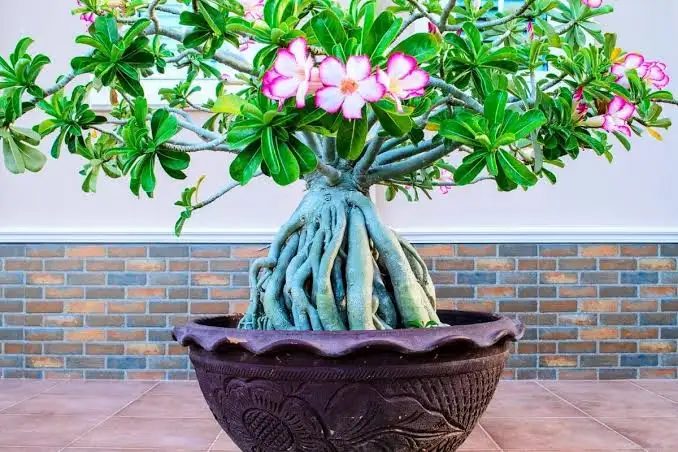
The desert rose (Adenium obesum) is a slow-growing plant, only growing about 12 inches per year. It is often used as a bonsai plant thanks to its thick succulent trunk, thin and delicate leaves, and luscious, deep pink trumpeting flowers. It is native to Africa, the Middle East, and Madagascar.It’s best planted in the spring, and it will die if exposed to frost and freezing temperatures.
Adromischus
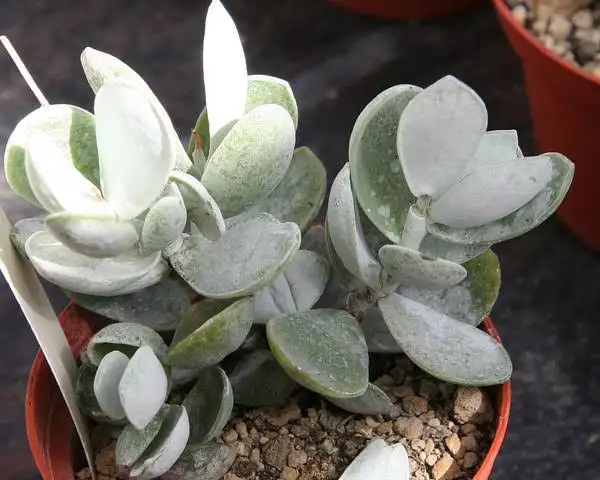
Adromischus is a genus of at least 28 species of small clumping succulents from South Africa.Adromischus species generally have small flowers with a greenish-white tube and pink or reddish corolla. They produce sufficient nectar to start a fungal infection, especially towards the end of the growing season.
Aeonium
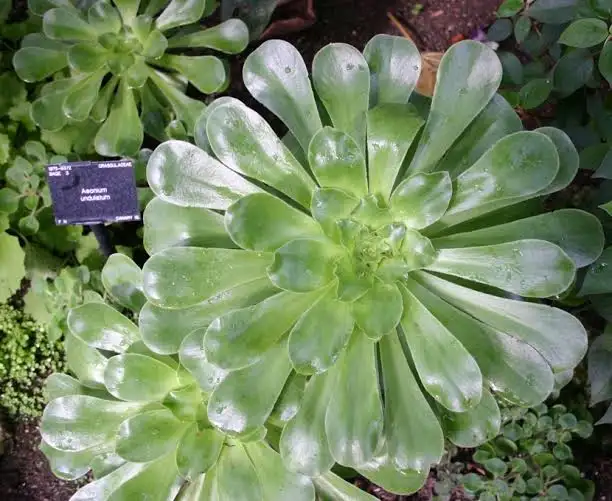
Aeonium, the tree houseleeks, is a genus of about 35 species of succulent, subtropical plants with unusually glossy, waxy leaves arranged in rosettes. The rounded leaves of the rosette structures are so perfect that these species are sometimes mistaken for artificial plants. These signature rosettes can be a solid color or variegated in white, yellow, red, and green. Small, star-like flowers grow in clusters from the center of the rosettes, but they are not particularly showy.
Agave plant

Agave plants generally are succulents with large leaves that end in spiny tips. There’s a lot of variety in the agave genus. There are large, stiff specimens that can grow to 10 feet or more in height and width. And there are the small, dish-sized agaves, as well as a few agave species with soft leaves and no spines. Agave foliage tends toward a blue-green in hardier varieties and a gray-green in warm-climate varieties. Some are variegated with gold or white markings.
Albuca

Albuca are perennial herbs growing from bulbs. The stem is sheathed in leaves with linear to strap-shaped blades.They can be 8 centimeters to well over one meter long and are flat or keeled. They are generally fleshy and sappy with a mucilaginous juice that inspired the common name “slime lilies”.The flowers of some species are scented, especially at night. They are borne in racemes, usually slender, but flat-topped in some species. The flowers may be on stiff, or slender, nodding stalks, held erect or drooping.
Anacampseros
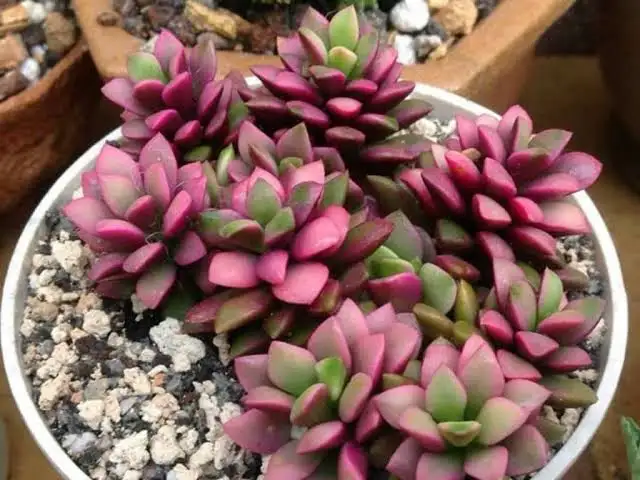
Anacampseros is a genus comprising about a hundred species of small perennial succulent plants. In habit they are small undershrubs or sprawling herbs that may form dense mats. Mature plants of many of the species form a small caudex or a tuberous root-stock. The leaves of most species are succulent and may be either lanceolate in shape or rounded. The flowers are actinomorphic with two caducous sepals and five fugacious petals. The petals may be white, pink, or even pale purple.
Bijlia

Small genus with only 3 dwarf perennials with fleshy, boat-shaped, swollen, unequal leaves which tend to branch only 2 or 3 times. Usually the leaf side nearest to the centre of the rosette is flattened, with the opposite (outer) surface having an inflated, unequally rounded appearance. These are coloured light green to yellow-green and under direct sun may take on red hues. Flowers are produced in clusters of 1-3 and they are photosensitive, opening in response to the midday sun and closing at night. Petals are wedge-shaped and yellow or orange.
Braunsia
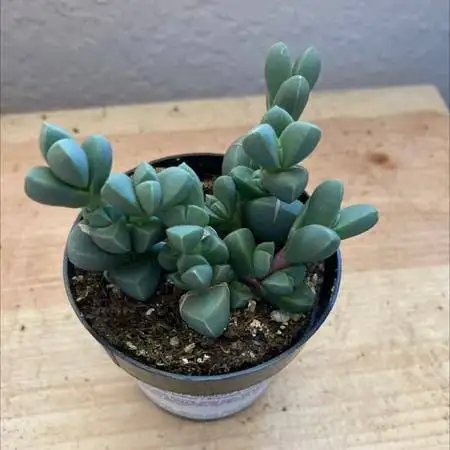
Braunsia is a genus of succulent plants. The plant only grows to 20 cm (8 inches), its opposite leaves grow in pairs, its flowers are either pink of magenta, occasionally white flowers. These are photosensitive, opening in response to the midday sun and closing in the evening. The leaves are almost equal in size and shape, fused to around half their length, and they are covered in small outgrowths called papillae which create a velvety texture.
Callisia

Callisia is a genus of flowering plants in the spiderwort family. They are generally, perennial plants with trailing or bushy growth habits and semi-fleshy stems and foliage. Callisia plants typically produce small, attractive 3-petalled white or pink-purple blooms and this may occur at any time of the year. They can sometimes be mistaken for the plants in the genus Tradescantia, which is also in the same family, Commelinaceae.
Carruanthus
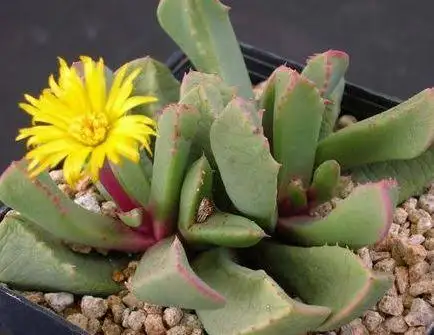
Carruanthus is a genus of flowering plants from the ice plant family Aizoaceae. The plants are tufted, tuberous-rooted perennials with a branching and clump-forming growth habit. Foliage is oppositely arranged and fused at the base, broadly triangular in shape with flattened to concave upper surfaces and unevenly ridged lower surfaces. Flowers are produced singly or in branched cymes. In cymes a central stem produces a flower at its growing tip first, followed by flowers from the ends of subsequent lateral shoots. The flowers are photosensitive, opening in response to the late afternoon sun and closing just after the sun sets. These flowers have linear to lance-shaped petals coloured yellow, with orange-red tips.
Ceropegia
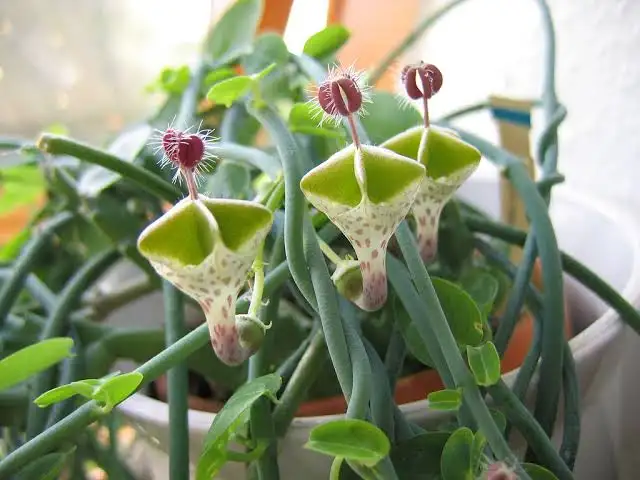
Ceropegia is a genus of plants within the family Apocynaceae, native to Africa. The stems are vining or trailing in most species, though a few species from the Canary Islands have erect growth habits. The leaves are simple and opposite, although they can be rudimentary or absent. Especially in certain succulent species, the leaves may also be thick and fleshy. The flowers have a tubular corolla with five petals most often fused at the tips, forming an umbrella-like canopy, a cage, or appendage-like antennae.
Cheiridopsis

Most species are clump-forming, a few are shrubby. The leaves are opposite and triangular in section, rarely flattened, the surface more or less velvety, which makes them easy to distinguish from species of the allied genus Argyroderma. Daisy-like flowers open during the day in summer, are borne singly and usually have yellow, rarely purple or red, petals. The name comes from the Greek “cheiris”, meaning “sleeve”. Each succeeding pair of leaves differs from the previous one in form, size, and relative unity of the leaves. Those most united wither in the resting period and form a papery sheath covering the succeeding pair of leaves during dormancy in dry, hot summer.
Conophytum
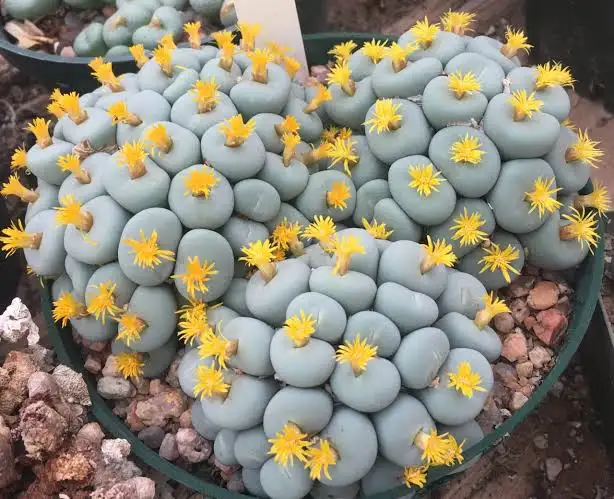
Conophytum is a large genus with around 110 succulent perennials with dwarfed or cushion-forming growth habits. Virtually stemless, these species produce cylindric, oblong, spherical or obconic-shaped fleshy leaves which are joined at the base and have small, dimpled openings in the centre (between the joined leaves). These vary in colour and may be green, brown, red, white-blue with spotted or striped patterning. They may be velvety or warty in texture and some possess structures called epidermal or leaf windows. Flowers are solitary or clustered in groups of 2-3, usually scented, with many daisy-like petals coloured red, orange, black, yellow, pink, pink-purple, white or some bicoloured combination of these colours.
Dinteranthus

The strange appearance of Dinteranthus have made them very popular in succulent collections. They are similar in habit to Lithops but grows above ground. They are also called mimicry plants as they show a striking similarity to their background rocks and are difficult to detect when not in flower. The Dinteranthus have a pebbly look and are commonly known as pebble plants or living stones; each species is associated with one particular type of rock formation and occurs nowhere else. This camouflage also reduces the need for chemical defences against herbivores.
Dudleya
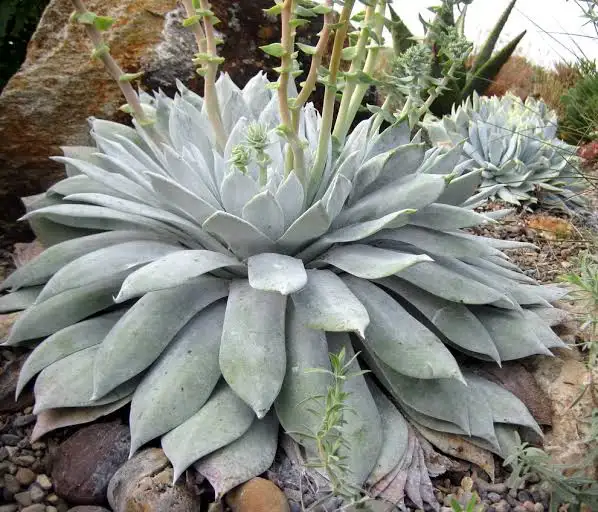
Dudleya, commonly known as liveforevers is a genus of succulent plants in the stonecrop family. The species come in multiple forms, some large and evergreen, others cryptic and deciduous. The flowers of Dudleya have parts numbered in 5, and when fruiting are filled with tiny, ovoid or crescent-shaped seeds.One of the most famous features of some Dudleya are their waxy coating. Numerous species have their foliage covered in an epicuticular wax, or farina.This waxy coating is usually white, chalky, and mealy, and is the namesake in many epithets, like chalk dudleya, powdery liveforever, and giant chalk dudleya.
Dyckia
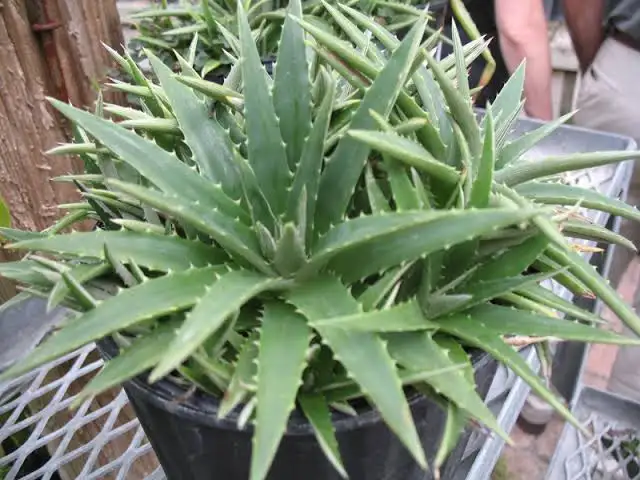
Dyckia is a genus of bromeliads. Dyckias typically have long narrow leaves. Almost all Dyckias have sharp spines or hooks around the margins of each leaf. Dyckias can be found in shades of red, green, yellow and silver. Many of the plants appear to have a beautiful silver flocking on the spines and edges of the leaf. The leaves form a tight rosette that often curves down around itself, and they can drape beautifully over the sides of containers. They range in size from just a few inches across to several feet wide. Many of the plants within the genus have tall flower spikes that tower above the foliage. The flower spikes often produce only very small flowers in oranges, reds and yellows.
Echeverias
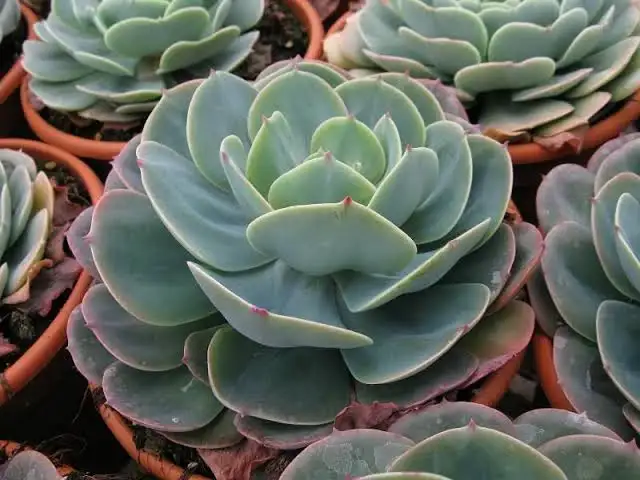
Echeverias are one of the most popular types of succulents and are frequently featured in succulent gardens, floral arrangements, terrariums, artwork, and even wedding cakes. Their stunning rosette shape, plump leaves, and large variety of colors give them a striking resemblance to flowers which makes them easy to decorate with. Their unique appearance and low maintenance needs have made Echeverias widely popular. They can range in size from a couple of inches tall to up to 12 inches tall depending on the variety.
Echidnopsis
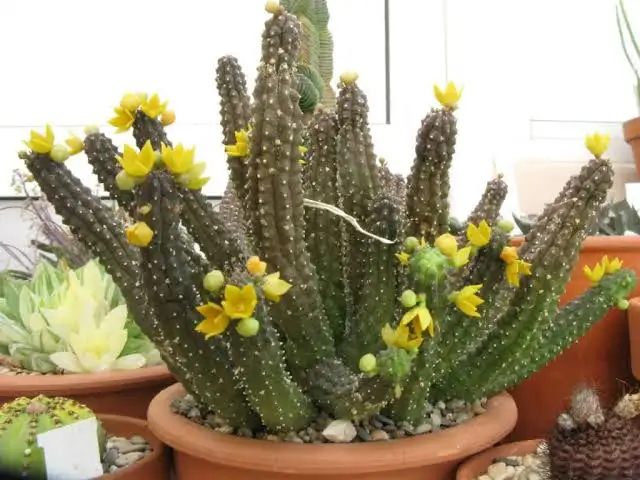
Echidnopsis is a genus of succulent, cactus-like plants. Its name derives from Greek and literally means “with the appearance of a snake”, referring to its stems which, in most species, with growth tend to crawl on the ground. They are often confused with cacti due to the longitudinal ribs, the hexagonal tubercles and the microscopic thorns sprouting off the tubercles. Their crawling, prostrate attitude make them the perfect ornamental houseplants. In their natural, arid habitat, they tend to form untidy shrubs, which look like some impressive bunches of tentacles, as the prostrate, serpent-like stems easily put roots as they touch the ground.
Euphorbia
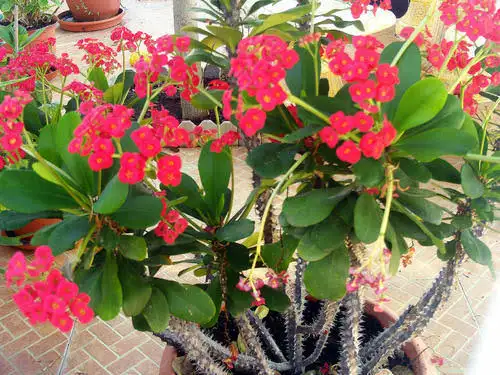
Euphorbia is a very large and diverse genus of flowering plants, commonly called spurge, in the spurge family. The plants are annual, biennial or perennial herbs, woody shrubs, or trees with a caustic, poisonous milky latex. The roots are fine or thick and fleshy or tuberous. Many species are more or less succulent, thorny, or unarmed. The main stem and mostly also the side arms of the succulent species are thick and fleshy. The deciduous leaves may be opposite, alternate, or in whorls. In succulent species, the leaves are mostly small and short-lived. The stipules are mostly small, partly transformed into spines or glands, or missing.
Faucaria

Faucaria is a genus of around 33 species of succulent subtropical flowering plants. They are generally small plants of 8 cm diameter, with thick triangular leaves. On the edges of the leaves there are upright teeth in opposite pairs that looks like an animal mouth. It may become bushy. The plants are light green, turning purple if exposed to strong sunshine. Golden yellow flowers appear in the center of the rosette. Commonly known by the name Tiger Jaws, these plants are popular with succulent enthusiasts.
Fenestraria
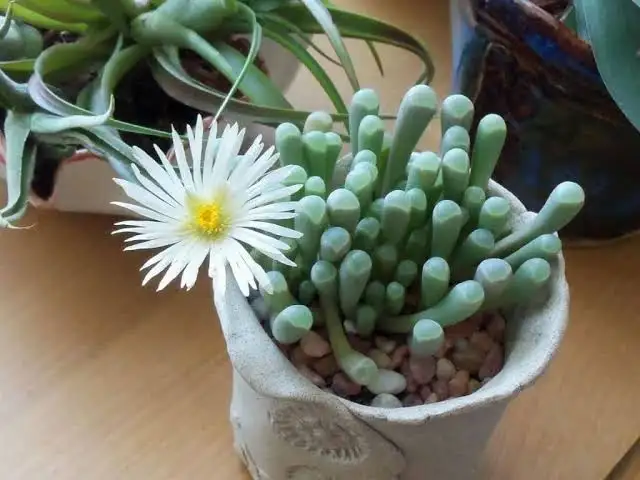
Commonly called “Baby Toes”, Fenestaria has small club-shaped leaves with fenestrate ends and form large clumps by offsetting. Flower colors range from pure white to rich golden yellow. The var. aurantiaca distinguish for the flowers that are bright golden yellow colored (never white).
Furcraea

Furcraea species are a type of succulents that have stiff and thick leaves that grow in the form of rosettes. Some of them have tall stems but some others are stemless. So, that’s not an identifier. Some of them even have pine-y leaves like agaves, which don’t help with the confusion.
The flower head of a plant—which includes flowers, stalks, stems and bracts—grows up to 40 feet in some Furcraea plants. So, when we say they are big, we mean they are BIG. These plants are also capable of producing hundreds of bulbils (which is a bulb-like axil of a leaf) that eventually fall to the ground.
Gasteria

Gasteria (Gasteria spp.) is a genus of relatively rare, aloe-like succulents. It sometimes goes by the common name of “ox tongue” because it typically has long leaves with a rough texture. Depending on the species, gasteria leaves also are often marked with interesting patterns and colors. Moreover, mature gasteria plants typically produce tubular, curved flowers in the winter to spring.
Glottiphyllum

The plants of the genus Glottiphyllum are small characterized by long fleshy leaves, oblong, sometimes wider or more cylindrical, depending on the species: it is the shape of the leaves that gives the name to this genre. The stems are short, not particularly hard, and give the plant a drooping posture: the plant is well suited in fact to be grown in hanging baskets or pots, from which the long leaves fall down with a very pleasant decorative effect.
Haworthia
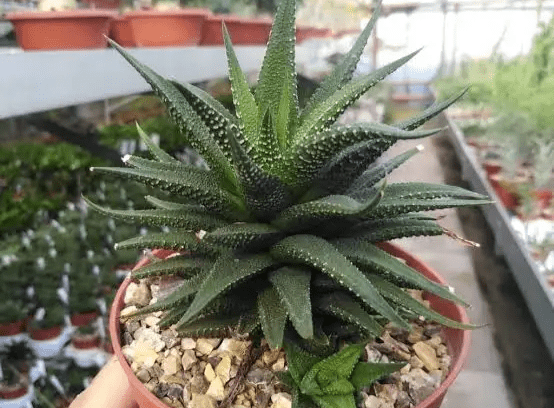
The Haworthia is a miniature succulent native to South Africa, and is one of the easiest houseplants to care for. It is characterized by its architectural structure, typically solitary columns which form in layers, though this can differ widely between varieties and even within the same species. A common Haworthia is characterized by its rosette-shaped, tightly packed leafy clusters. Some are firm, tough, and dark green, whereas other species are softer and even translucent. Those of the firm, dark green variety are typically dotted with white spots and can turn a rich hue of purple-red when exposed to full sun.
Hesperaloe
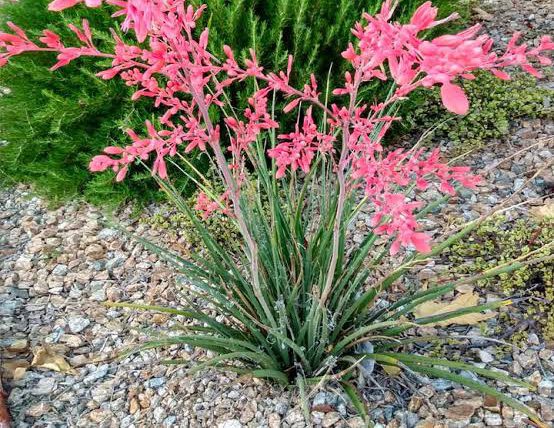
Hesperaloe (false yucca) is a genus of flowering plants in the family Asparagaceae, subfamily Agavoideae. It contains perennial yucca-like plants with long, narrow leaves produced in a basal rosette and flowers borne on long panicles or racemes. The species are native to the arid parts of Texas in the United States and Mexico and are sometimes cultivated as xerophytic ornamental plants.
Huernia
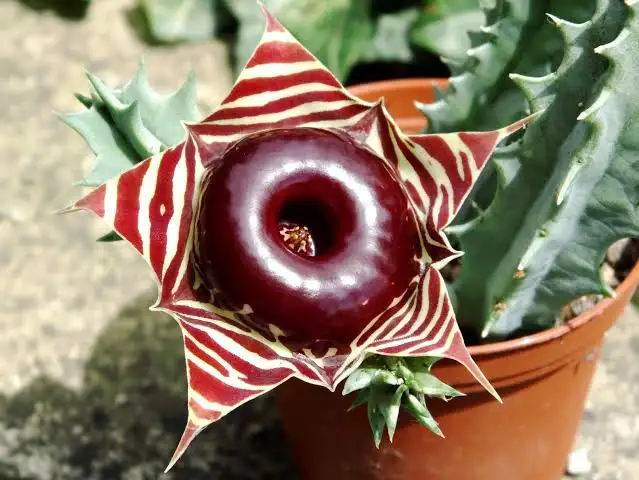
The genus Huernia consists of perennial, stem succulents. The flowers are five-lobed, usually somewhat more funnel- or bell-shaped than in the closely related genus Stapelia, and often striped vividly in contrasting colors or tones, some glossy, others matte and wrinkled depending on the species concerned. Frequently the flowers are colored a variation of red, yellow or brown.
Juttadinteria

Juttadinteria genus is an aizoaceae from Namibia’s desert areas and savannahs. They are small plants: they reach 20-25 cm in height, they have a slow growth. From the green stem, a series of triangular, succulent (as well as the stem, the rest) and elongated leaves come out. They grow paired, placing themselves on opposite sides of the stem. The flowers are daisy shaped, mostly white, and flourish in autumn and winter: due to the origin of the plant, below the equator, its life cycle is in fact invert.
Kalanchoe

The genus Kalanchoe includes more than 100 species of plants, but only a few are regularly seen in cultivation. Kalanchoe plants are thick-leaved, slow-growing succulents on average taking between two and five years to reach mature size. Available in pretty shades of red, pink, yellow, and white, Kalanchoe can be easily found at many grocery stores, nurseries, and florists, especially around the holiday season.
The clusters of tiny flowers produce a large bloom held aloft on stems above the majority of the foliage. The deep green, scalloped leaves of the kalanchoe are just as attractive as the flowers. The sculpted foliage persists after bloom and provides for a handsome plant. The starry flowers are long-lasting and bloom from winter to spring.
Lithops

Lithops is a genus of succulent plants in the ice plant family. Individual Lithops plants consist of one or more pairs of bulbous, almost fused leaves opposite to each other and hardly any stem. The slit between the leaves contains the meristem and produces flowers and new leaves. The leaves of Lithops are mostly buried below the surface of the soil, with a partially or completely translucent top surface known as a leaf window which allows light to enter the interior of the leaves for photosynthesis.
During winter a new leaf pair, or occasionally more than one, grows inside the existing fused leaf pair. In spring the old leaf pair parts to reveal the new leaves and the old leaves will then dry up. Lithops leaves may shrink and disappear below ground level during drought. Lithops in habitat almost never have more than one leaf pair per head, presumably as an adaptation to the arid environment. Yellow or white flowers emerge from the fissure between the leaves after the new leaf pair has fully matured, one per leaf pair.
Lenophyllum

Lenophyllum plants are bushy and small in size. In fact they reach a maximum height of just twenty centimeters. From simple, non-branched stems, there are triangular shaped pairs of leaves, with concave and very fleshy page, and green or green-gray according to the species.
The flowering occurs between June and October, with small yellow five-petal flowers blooming solitary or gathered in racemas or end ears. The flowers are not particularly noticeable and the interest in the plant is mainly due to the decorative function of the foliage. For their simplicity they are suitable for shrubbery and desert or rocky gardens even in warmer climates.
Larryleachia
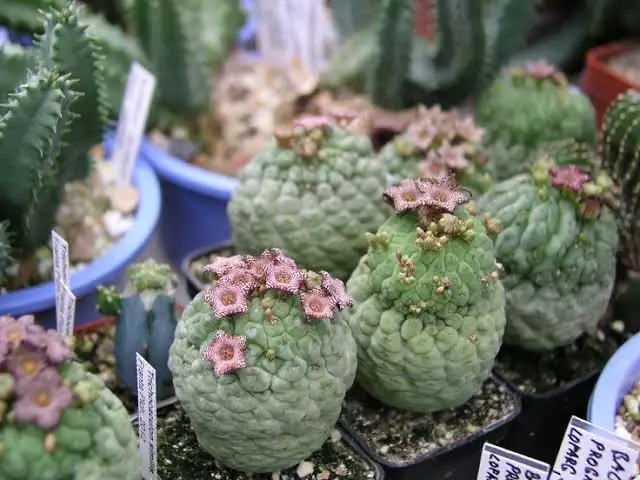
Mangaves resemble compact, symmetrical agaves with succulent leaves. They typically grow to 8–24 inches high and up to 18 inches wide, although some can grow up to 4 ft high and 6 ft wide. The leaves of the plant are stiff, sometimes fragile, and variable in foliage color and patterns. Mangaves flower in June and July, producing brown flowers.
Mangaves inherit the drought-resisting traits of their parent plants. They can resist high temperatures and direct sunlight, but prefer shade. The plant can survive below freezing temperatures, but can become damaged if the temperature drops below -6 degrees Celsius.
Monanthes

Monanthes is a small genus of ten species, of smaller growing sometimes fragile succulents. Endemic to the Canary Islands with the main center of their diversity on Tenerife. All are perennial except for one which is an annual.
Monanthes are varied in their form some having ground hugging rosettes others small shrubs such as Monanthes muralis. The most well known is Monanthes polyphylla has cone like upright rosettes which readily offset to 3 to 5 cm tall and 6 to 15 mm in diameter Flowers are unusual almost looking petal less orange to yellow born terminally, they persist for quiet a long time.
Orbea

The genus Orbea includes around 56 species of leafless stem succulents forming clumps and mats of vegetation. The green stems are four-angled with prominent pointed tubercles and may develop attractive purple blotching in bright sunlight. Stems generally branch from their base.
Orbea have unusual five-lobed flowers, generally with a raised ring or annulus around the centre. The flowers of many, but not all species produce a putrid odour of rotting carrion to attract blow flies as pollinators. The petal edges of some species carry numerous hairs that vibrate with the slghtest air motion. This flickering is thought to attract pollinators.
Othonna

Plants of the genus Othonna are part of the family Asteraceae and are, therefore, close relatives of sunflowers and other flowering plants. They are very similar to Senecio and differ from it only for few details.Their leaves are often succulent, elongated, with different shapes, sometimes very decorative. When deciduous, however, there is usually a woody stem equipped with a caudex – an enlarged swelling at the base of the stems that has the function of a water and nutrients supply. Yellow daisy-like blooms emerge and wave cheerily an inch or so from above the foliage.
Oscularia
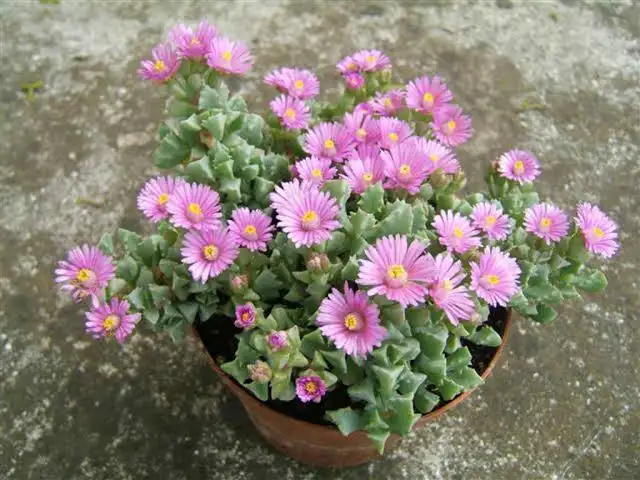
The most superficially recognizable feature of the genus is the strange shape of the leaves, which are grey-green and waxy. They are triangular in cross-section (3 angled) and can be sickle, club or mouth shaped. The name “Oscularia” actually means “group of tiny mouths” in Latin, and refers to the appearance of the toothed leaves in some species. The stems are often red, and the leaves can become red too during times of drought. Abundant, almond-scented, daisy-like white or pink flowers appear throughout the summer.
Pachyphytum

The species of the genus Pachyphytum are perennial succulent plants. They grow as hairless rosette plants. The usually short shoots are upright up to 70 cm young and later prostrate to longer than 1 m. The usually simple and occasionally basally branching shoots can reach a diameter of up to 3.5 cm. The rosettes have a diameter of 6 to 20 cm and are made up of 10 to 40, rarely up to 80, clearly separated leaves that are often intensely blue frosted. Towards the shoot tip, the leaves are much more crowded together. The young leaves are more or less erect, later spreading and the older ones often curled back. They are obovate to spatulate or elliptical-oblong to lanceolate and usually end blunt to pointed.
Peperomia
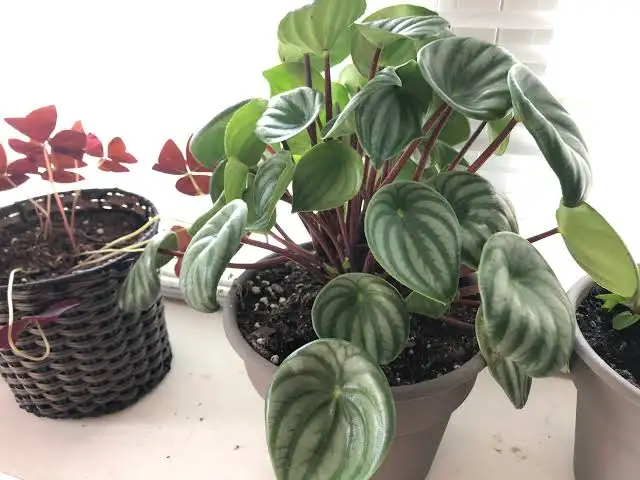
Peperomia are native to tropical and subtropical regions of the world, in particular Central America. Most are compact perennial plants which are grown for their ornamental foliage, rather than their flowers, which are quite unimpressive. Peperomia plants are normally compact, rarely growing more than 12 inches in height in the indoor setting, making them ideal for containers, balconies or small indoor spaces. They normally have sturdy stems and many have fleshy leaves, with succulent characteristics.
Portulacaria afra (Elephant’s food)

The attractive, evergreen succulent can grow to eight feet or more, in its natural enviornment. It has small, circular, fleshy, bright green foliage on reddish-brown stems. The leaves of these plants are edible and have a tart flavor. In its native habitat, the plant is heavily browsed and eaten by elephants, wild game, and tortoises. Elephants eat parts of the plant, and spit out the leaves and seeds, which help to propagate the plant. It produces pink, star-shaped flowers in late winter to early spring, but rarely blooms the southwest desert. The flowers are a good source of nectar for birds and insects.
Pseudolithos
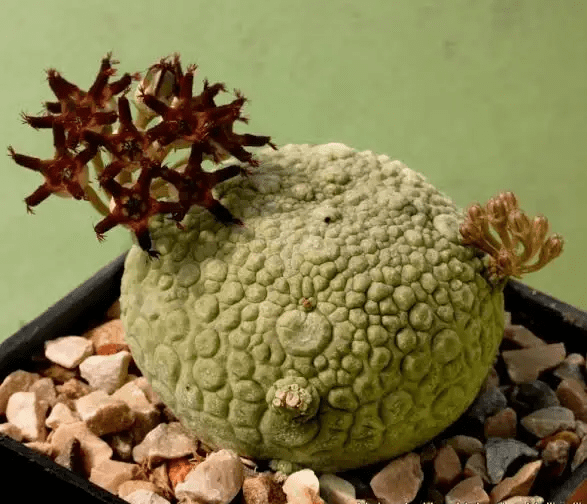
Pseudolithos plants have a single stem or a little bunch of stems, with a pitted surface, looking almost like a stone with a very irregular top or some reptile’s pat: this is an effect given by the numerous tubercles at the base of the stem,barely noticeable. They don’t exceed 2-7 centimeters of height. This feature, together with their lumpy appearance, make them really sought after by succulent collectors. From the broken little stems, latex leaks off. Stems are tetrangular or globose (like in P. migiurtinus) and can be bluish-green or light brown, 1 to 5 centimeters long and 1-6 millimeters wide.
Rabiea

Rabiea is a small genus of six species that love to grow in dry, open places among the rocks on the slopes, or in crevices of the rocks.It is a small succulent with very thick, triangular-shaped leaves that grow in very compact rosettes. Depending on the species they may have peculiarities such as serrated edges or light coloured spots as a pigmentation. Rabieas tend to be groundcovering and form wide mats. They don’t exceed 10-15 centimeters in height and, usually (but it depends on the species) 20-30 centimeters in width. Flowers are yellow, daisy-like, with a lot of very thin petals. They are medium-sized and showy. Their special feature is that they bloom at the end of winter, often in the afternoon.
Rosularia

Turkish stonecrop, aka Rosularia, is a rosette forming succulent that looks similar to Sempervivum or Echeveria but is actually related to Kalanchoe and jade plant. Rosularia grows in small rosettes with flat green succulent foliage, much like hens and chicks. Depending on variety, Rosularia foliage often has red, purple or yellow margins that may be covered in tiny hairs, called cilia. When present, these small hairs help plants capture water and nutrients and transport them to the root zone. Rosularia flowers are small, tube or funnel shaped atop tall stems that grow up from the center of the rosette. These blooms can be white, yellow, pink or purple and may even be variegated, depending on variety.
Sansevieria

The genus Sansevieria, sometimes simplified in Sanseveria, groups a series of perennial plants, of the same family of the agave but also of the sting, “Ruscaceae”, which is characterized by beautiful and large upright leaves, thick and generally bright colors. They are plants of very variable height: from about 30 cm to over one meter. The stem is absent; as root they generally have a rhizome. A rhizome is a modified stem that serves certain species to store water and nutrients to live in climates with unfavorable periods.
Sansevieria are generally divided into two types: those with long lance-shaped or cylindrical leaves, more frequent and requested in the gardening world, and those with rosette-shaped leaves, less common and less popular. Their flowers develop in an inflorescence called in botany “raceme”, but which, in fact, is a simple bunch, and are of different colors depending on the species: greenish-white, pink, purple, or red.
Sedum
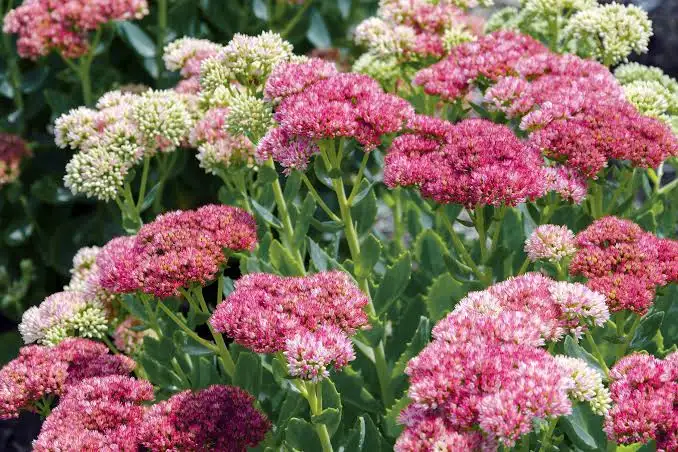
The Sedum genus includes a large number of small, perennial, groundcovering succulents with very low requirements. Sedum is a vast genus, and includes very diverse plants. In general they are small in size (reaching 20 to 50 cm in height, depending on the species) with a groundcover or bushy habit. Their leaves are very fleshy and can have different shapes, wide or more rounded. They grow in rosettes that are usually bright green, sometimes with purple or reddish pigmentation. The flowers are usually small but brightly coloured. Sedums are used for borders, green carpets or in pots as hanging plants.
Sempervivum
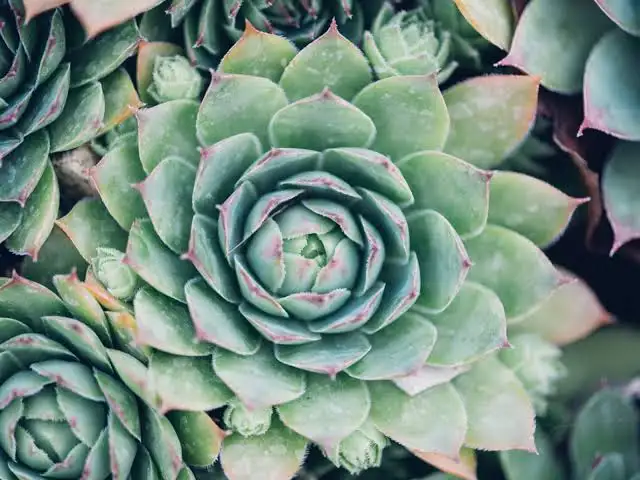
The Sempervivum genus groups about forty species, but never as in the case of these succulent plants the conditional is a must because it is a constantly evolving genus. These are plants with different stems from which rosettes of different sizes come out, ometimes larger, other they grow in height, they usually have got numerous, long and narrow leaves.
Rosettes can have different color nuances: light green, violet, reddish. They often have different shades on the tips, which make them very decorative. From the botanical point of view they are monocarpic: that means they are destined to dry and die after flowering and making seeds (which usually happens after a few years). New rosettes come out and they will take the place of the old ones. Flowers can have very different colors: they are often red or rose, rarely yellowish or white.
Senecio

The genus Senecio includes more than 1,500 species, spread all over the world. Among these, only a few have the characteristics of succulents: usually the fleshy parts are the stems and leaves. Senecios can have various dimensions: ranging from 20-30 cm to over one and a half metres in height. The succulent stems can have different thicknesses and forms, and the shape of the leaves is also extremely variable. Flowering occurs usually in Autumn.
Trachyandra
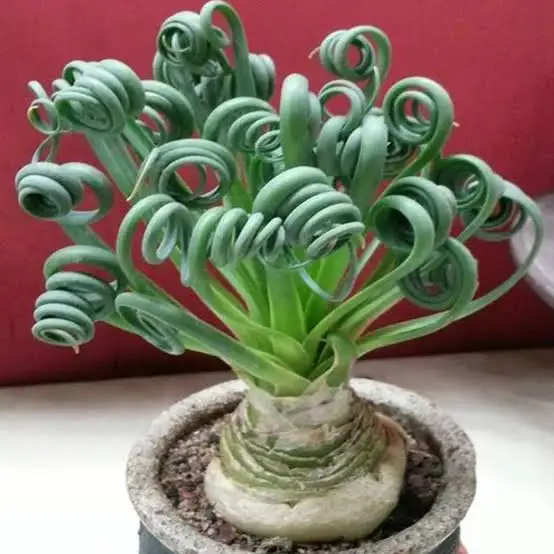
The Trachyandra plant is very unique as there is no other plant quite like it. This plant is a rare succulent that looks stunning as it has green ribbon-like leaves which grow in coils. This interesting plant can grow up to ten inches tall. It originates in South Africa and can be grown as a houseplant. The foliage is fairy-like and will make a great addition to any succulent collection. The Trachyandra plant has between four and eight ribbon-like leaves, which are greyish-green in color. They have a unique growth pattern and are curled or spiraled. A mature plant can have leaves that are 6 to 10 inches in length. The Trachyandra is a perennial and is part of the Asphodelaceae family of succulents.
Tradescantia
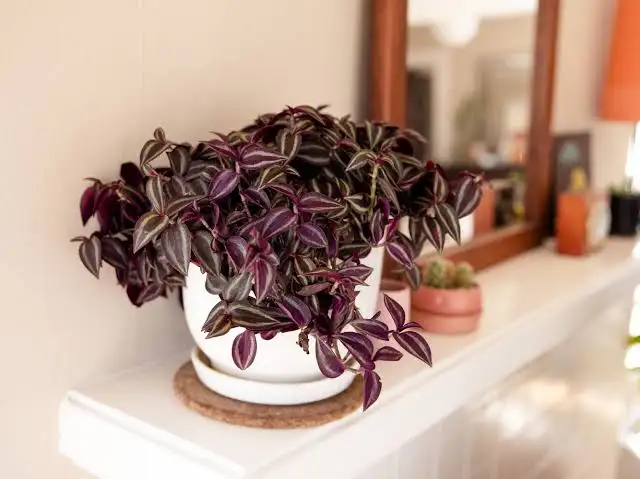
Tradescantia is a genus of 85 species of herbaceous perennial wildflowers commonly found individually or in clumps in wooded areas and open fields. Tradescantia grow 30–60 cm tall, the leaves are long, thin and blade-like to lanceolate, from 3–45 cm long. The flowers can be white, pink, purple or blue, with three petals and six yellow anthers (or rarely, four petals and eight anthers). The sap is mucilaginous and clear. There are a multitude of different varieties, boasting greens, yellows, pinks, and purples. Many varieties also produce small clusters of flowers if the light conditions are favourable.
Titanopsis
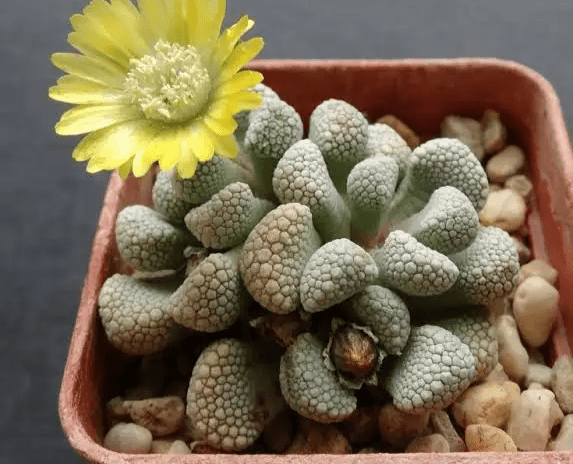
The genus Titanopsis includes 6 to 10 species. The peculiarity of these plants lies in its leaves, which widen in an evident way towards the tip and are covered of small swellings, like many bubbles, appearing on its surface and in particular on the very point. They have a lighter coloration, almost white, than the rest of the leaf which is greyish blue, and increase the mimetic attitude of the plant. Flowers are daisy-like, 2-3 centimeters wide and can be white (with various pinkish shades), yellow or red. They sprout from the center of the rosette in early spring.
Tylecodon

The genus Tylecodon includes 45 succulent plants. It is divided into two groups: dwarf to small shrubby species, and medium to large species. They are widespread in rocky, dry habitats and savannas. In Tylecodon, instead, leaves show a spiral arrangement and, also, deciduous in Summer. The height of the plants and their overall appearance in fact vary greatly depending on the species. They range from dwarf species such as T. reticulatus, just over ten centimetres in height, to giants of over three metres such as T. paniculatus. Flowers are generally tiny and bell-shaped, with five petals and vary in colour and size according to the species. They are pollinated by bees and birds in their natural habitat.
Umbilicus

Umbilicus is a genus containing roughly 17 herbaceous, succulent perennial species in the Crassulaceae family. They produce long, dimpled foliage from the base and small flowers. Flowers are arranged on terminal racemes. This triangular-shaped structure is a form of unbranched inflorescence where flowers are attached by equal stalks and the oldest flowers are formed at the base and new blooms from the tip as the plant grows. They are usually coloured yellow-green or pink, sometimes opening from pink buds, the flowers are bell-shaped to tubular in appearance.